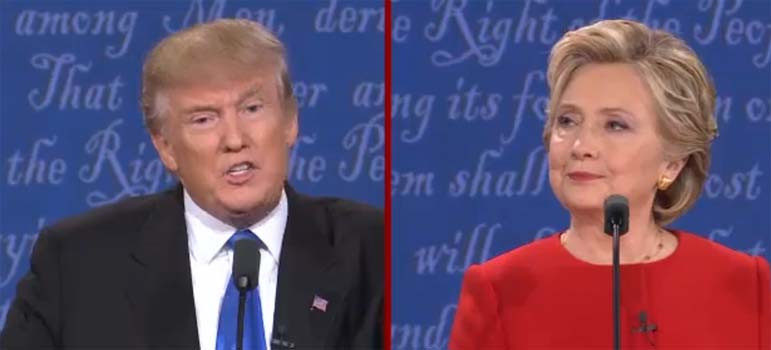
As we watch the candidates do their weekend fly-arounds, let's discuss possible outcomes Tuesday night.
Here are six Electoral College scenarios. You decide which is most plausible (and here's a link to the 270towin.com site, if you want to rearrange the states).
The Status Quo. We've had three of them in recent history - 1988, 2004 and 2012.
To recap: In 1980, Ronald Reagan captured 44 states in taking away the presidency from Jimmy Carter. Eight years later, George H.W. Bush won 40, earning him the right to succeed the Gipper.
Seven states flipped from one party to the other in those two elections - Georgia (the only one to go from blue to red), Iowa, Massachusetts, New York, Oregon, Washington and Wisconsin. But the end result was just as deadly: 489 electoral votes for Reagan; 426 for Bush.
More recently, there's the 2004 presidential election in which only three states switched sides from the previous contest - New Hampshire (red to blue), Iowa and New Mexico (both blue to red). In 2012, only two states moved - Indiana and North Carolina - plus one electoral vote in a Nebraska congressional district, all going into the GOP column (Barack Obama becoming the first presidential incumbent since FDR in 1944 to be returned to office with fewer electoral votes).
If you buy into this scenario, disregard the latter two contests and go back to 1988 and the idea of one party trying to extend its hold on the White House for an extra four years.
If so, Clinton wins the White House, but with fewer states and electoral votes than Obama in 2012. But what the hey, a win's a win (and she'll have a couple of months to figure how to spin the results into talk of a mandate).
The Clinton Squeaker. Obama was re-elected with 51.1% of the vote in 2012, his margin of victory falling from 7.3% in 2008 to 3.9% in 2012.
If the polls continue to trend against her, Hillary Clinton could see another 50% drop-off in the Democratic margin, with her margin of victory coming in somewhere around 2%. If so, then Democrats could be in a nail-biter.
The Atlantic's Ron Brownstein popularized a phrase for the Democrats' advantage in presidential politics - what he calls "the blue wall". It denotes the 18 same states that have voted for Democratic candidates going back to 1992. Along with the District of Columbia, they give Hillary 242 electoral votes going into Tuesday night.
Let's give Mrs. Clinton all of those states (that assumes she closes the deal in Michigan, Pennsylvania and Wisconsin - indeed, she's been advertising heavily in what were once assumed to be "safe" states). Add Florida to her column and Clinton's at 271 electoral votes. Game over.
But if Mrs. Clinton can't pick up Florida or North Carolina? Then she has to pick up the following to get to 273: Colorado, New Hampshire, New Mexico and Virginia. It'd be the closest verdict since the Bush-Gore squeaker of 2000. And for the side that loses: about as easy to let go of, as was that aforementioned outcome.
The Clinton Landslide. Now let's suppose the map goes bluer than Trumpeteers fear on Tuesday night.
Let's start with that 273 and build out.
The best-case scenario for the "I'm With Her" crowd (and this is leaving out some real wishful thinking, like Georgia and Texas): add Arizona, Florida, Nevada, North Carolina and Ohio to the Clinton ledger.
The new total: 352-180.
If you want to go nuts, let's toss in Utah. It hasn't gone Democratic since 1964, but could if there's a fratricide involving two other candidates (more on that in a moment). Clinton 45 now climbs to 358 electoral votes - still short of Bill's 370-plus totals the two times he ran - not that he'd remind her of that at the Thanksgiving table.
The Trump Squeaker. Now, the stuff that keeps the Clintonistas up at night: how Donald Trump shocks the world. Let's begin again with Clinton in possession of those reliable 242 electoral votes and Trump at only 174 (I'm leaving several of Mitt Romney's 2012 states uncolored . . . which we're about to change).
What if Trump can't crack the blue wall and pick off the likes of a Michigan or Pennsylvania or Wisconsin?
The inside straight goes something like this: Florida, North Carolina and Utah back in the red column. That puts Trump at 206 electoral votes, which is Romney's total.
Add in Ohio and Florida and the sum rises to 253.
From here, since Trump can't tear down the wall, the schematics get complicated. Iowa and Nevada put Trump at 265. New Hampshire takes it to 269 (in theory, good enough for a win as a presumably Republican House returning to Washington in January would break the tie).
But maybe that's not necessary: one additional electoral vote, courtesy of Maine's 2nd Congressional District, takes Trump to the magical 270.
The Trump Landside. So let's begin with Trump holding 270 electoral votes.
Under this scenario, the blue wall first set up by the first Clinton run begins to crumble. Michigan and Pennsylvania go Republican for the first time since the first Bush presidential victory (we're guessing there's no congratulatory call from Kennebunkport or wherever the former First Family is huddled).
New total: 306 electoral votes for Trump.
Toss in Colorado and Virginia, for good measure (this is assuming that hidden Trump votes really exists and the polls have no idea what the heck is going on), and the Trump surge rises to 328 electoral votes.
Welcome To Hell. And that would be no resolution once the votes have been tallied on Election Night.
How does that happen?
Let's go back to where Trump had 269 electoral votes, before he got to 270 in Maine. Take Utah and its six electoral votes out of the column. Only, they don't go to Clinton. Instead, Evan McMullin gets the 6 electoral votes (recent polling suggests this won't happen, but the race remains fluid).
New total: Clinton 269, Trump 263 and McMullin 6.
Either the 538 electors play fast and loose with their state's results (one "faithless elector" in a purple state, for example, flipping from Trump to Clinton and giving her the contest).
Or, the House decides which of the three deserves the presidency when it reconvenes in January.
Yes, two more months of presidential drama.
Are we having fun yet?
Comment by clicking here.
Bill Whalen is a research fellow at the Hoover Institution, where he studies and writes on current events and political trends. In citing Whalen as one of its "top-ten" political reporters, The 1992 Media Guide said of his work: "The New York Times could trade six of its political writers for Whalen and still get a bargain." During those years, Whalen also appeared frequently on C-SPAN, National Public Radio, and CNBC.


 Contact The Editor
Contact The Editor
 Articles By This Author
Articles By This Author